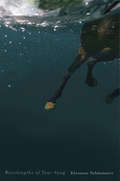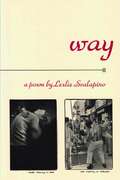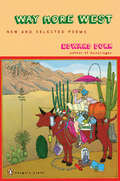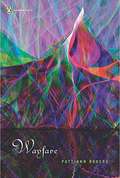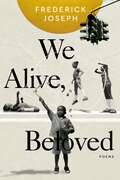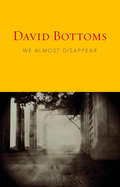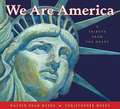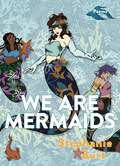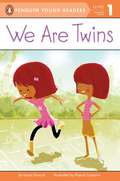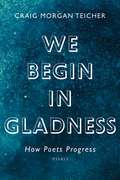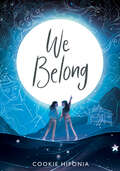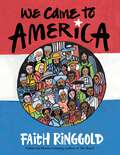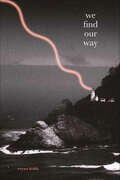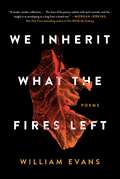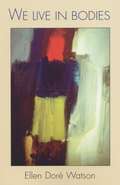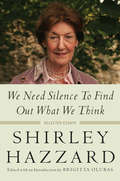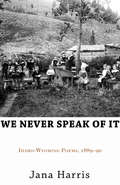- Table View
- List View
Wavelengths of Your Song
by Eleonore SchönmaierAt night we swim / following the fence: / diverted / we enter the net / shaped like a heart / and in the heart the hook / guides us to the back A stunning unfolding of memory, Wavelengths of Your Song juxtaposes a childhood in the northern Canadian wilderness with the adventures of an international creative life. Genuine environmentalism is at the heart of this collection. Migrations of birds and humans lend their songs to the vivid writing and a tangible, sensory reality emerges from their sounds. Music by Beethoven and Rzewski, paintings by Norval Morrisseau and Kandinsky, and writing by Kafka and Celan, inspire Eleonore Schönmaier's poetry. She takes the reader on unexpected journeys skiing across frozen lakes, cycling along Dutch canals, or hiking in Malta and New Zealand. With surprising, at times breathtaking connections, she illuminates hot air ballooning, canoe camping, planting trees on Vienna rooftops, and the bathing of a black horse in the North Sea. In poems that travel extensively around the globe, in lists for living well, and in love letters, Eleonore Schönmaier takes the reader on a journey along the wavelengths of the ocean, sound, and the physics of light.
Wavelengths of Your Song (Hugh MacLennan Poetry Series)
by Eleonore SchönmaierAt night we swim / following the fence: / diverted / we enter the net / shaped like a heart / and in the heart the hook / guides us to the back A stunning unfolding of memory, Wavelengths of Your Song juxtaposes a childhood in the northern Canadian wilderness with the adventures of an international creative life. Genuine environmentalism is at the heart of this collection. Migrations of birds and humans lend their songs to the vivid writing and a tangible, sensory reality emerges from their sounds. Music by Beethoven and Rzewski, paintings by Norval Morrisseau and Kandinsky, and writing by Kafka and Celan, inspire Eleonore Schönmaier's poetry. She takes the reader on unexpected journeys skiing across frozen lakes, cycling along Dutch canals, or hiking in Malta and New Zealand. With surprising, at times breathtaking connections, she illuminates hot air ballooning, canoe camping, planting trees on Vienna rooftops, and the bathing of a black horse in the North Sea. In poems that travel extensively around the globe, in lists for living well, and in love letters, Eleonore Schönmaier takes the reader on a journey along the wavelengths of the ocean, sound, and the physics of light.
Way
by Leslie ScalapinoComprising one long poem narrated in the first person, this volume, set in a bleak urban environment, conveys a sense of alienation and angst. Almost compulsively, Scalapino (That They Were at the Beach, etc.) returns to the same characters and events: dying "bums," car crashes, and surreal sexual encounters, changing the context in which they appear to create subtle variations on her themes. The constantly shifting imagery reflects both the author's fascination with language, and all of its permutations, and her reluctance to draw conclusions. Tentative, she frequently defines experience in terms of what it is not, finding a void, a lack: describing the sight of the dead bodies of several vagrants being thrown into the river, she writes: "not being special and/ the corpses that are put into the/ river coming there for burial though we are not/ in that situation would be/ in that floating there/ of our own culture/ when the action would/ not beof our own culture." Stylistically sparse, abstract and nonreferential, the poem is highly fragmented, enhancing the feeling of estrangement, as though the narrator were unable to complete a thought or communicate an idea. Unfortunately, readers may find this to be frustrating, as the images and events seem randomly associated and gain meaning only through repetition and modification. Copyright 1988 Reed Business Information, Inc.
Way More West
by Edward Dorn Dale Smith Michael RothenbergAn essential anthology of an innovative American poet Edward Dorn was not only one of America's finest poets but a rare critical intelligence and commentator. He was a student of Charles Olson, who helped him to see the American West as a site for his quest for self-knowledge; at the core of his work is a deep sense of place and the people who occupy it, underpinned by a wry ironic dissent. It was Dorn's comic-epic masterpiece, Gunslinger, which began appearing in 1968 and had already become an underground classic by the time it was published in its entirety in 1974, that established his reputation in the wider world. This new volume brings together poems from Dorn's entire career, including previously uncollected work.
Way More West
by Edward DornAn essential anthology of an innovative American poet Edward Dorn was not only one of America's finest poets but a rare critical intelligence and commentator. He was a student of Charles Olson, who helped him to see the American West as a site for his quest for self-knowledge; at the core of his work is a deep sense of place and the people who occupy it, underpinned by a wry ironic dissent. It was Dorn's comic-epic masterpiece, Gunslinger, which began appearing in 1968 and had already become an underground classic by the time it was published in its entirety in 1974, that established his reputation in the wider world. This new volume brings together poems from Dorn's entire career, including previously uncollected work. .
Way Out in the Desert
by Jennifer Ward T. J. MarshThis toe-tapping text will have you singing along with the lovable creatures of the desert in no time! Filled with vibrant illustrations of many of the charming plants and animals that call the Sonoran Desert home, Way Out in the Desert is a wonderful teaching tool that takes you on a trip down memory lane. If you remember singing Over in the Meadow as a child, now you can give your children their own memories of this timeless tune. So take a child on a trip where Way out in the desert having fun in the sun lived a mother horned toad and her little toady one...
Wayfare
by Pattiann RogersA lively new collection from one of America's most celebrated contemporary poets Denise Levertov has called acclaimed poet Pattiann Rogers "a visionary of reality, perceiving the material world with such intensity of response that impulse, intention, meaning, interconnections beyond the skin of appearance are revealed. " In her new collection, Rogers takes the reader on an exploration of human endeavor. Full of color and action, wonder and fear, these poems investigate, reflect upon, and create experiences relative to music, art, and theater, as well as to the universe and its creatures, large and small. They are distinguished by the penetrating vision and avid imagination that have made Rogers one of today's most outstanding poets. .
We Alive, Beloved
by Frederick JosephNYT Bestselling Author, Frederick Joseph, explores a new genre in this captivating poetry collection that seeks to find joy in moments of difficulty whether through illuminating the beauty of being Black, highlighting the hope that can be found in childhood, or by sharing intimate truths revealed on a mental health journey. This book will appeal to both new and established readers of poetry.Step into the world of We Alive, Beloved, where its words will resonate within the deepest corners of your soul, leaving a mark on your heart and a renewed appreciation for the beauty of being alive. We Alive, Beloved moves beyond being a poetry collection; it's a celebration of the profound aspects of our existence. Each poem seeks to immortalize the fleeting moments of joy, love, resilience, and inspiration that often slip through the grasp of our fast-paced lives. In this poetic testament, we defy the ephemeral nature of beauty and goodness, daring to clutch onto these facets of life for just a little longer. With words that stand as guardians against the relentless march of time and the ceaseless tides of change, trauma, and grief, this collection becomes a sanctuary of light in a world that sometimes seems dim. We Alive, Beloved explores a rich tapestry of themes, from the intricacies of relationships and the heartache of loss, to the wide-eyed wonder of existence and the challenges of exploring the possibility of parenthood in our modern age. Each poem reaches out to readers, offering a mirror to their own journeys and emotions, inviting them to be seen and acknowledged in its lyrical embrace.
We Almost Disappear
by David Bottoms"An exquisite storyteller."-The Southern Review"David Bottoms's poems just get better and better."-The Atlanta Journal-Constitution"One finds here what one expects in a book of good Southern poems: clear narratives . . . evocative images, searching irony, and meditative poise." -Library JournalRooted in the customs of Southern families and peopled with undertakers, bluegrass musicians, daughters practicing karate, and elderly parents, David Bottoms' poems are generous, insightful, and lean headlong into familial wisdom. Past and present interweave with grandmothers spitting tobacco juice, ponds "filled with construction runoff," and the boyhood home-site paved over for a KFC. This is Bottoms' most personal and heartbreaking book.From "My Daughter Works the Heavy Bag":A bow to the instructor,then fighting stance, and the only girl in karate class faces the heavy bag.Small for fifth grade-willow-like, says her mother-sweaty hair tangled like blown willow branches.The boys try to ignore her. They fidget against the wall, smirk,practice their routine of huff and feint.Circle, barks the instructor,jab, circle, kick, and the black bag wobbles on its chain.Again and again, the bony jewels of her fistjab out in glistening precision,her flawless legs remember arabesque and glissade.Kick, jab, kick, and the bag coughs rhythmically from its gut.The boys fidget and wait . . . David Bottom, Georgia's Poet Laureate, was inducted into the Georgia Writers Hall of Fame in 2009. He teaches at Georgia State University and co-edits Five Points magazine. He lives in Marietta, Georgia.
We Are All From Somewhere Else: Migration and Survival in Poetry and Prose
by Ruth Padel*First published as The Mara Crossing, now with new and updated material*'A prodigy, a book of wonders. Wonder, pity and terror, the searing section of voices in transit coercing compassion - and beyond that, empathy' IndependentHome is where you start from, but where is a swallow's real home? And what does 'native' mean if the English oak is an immigrant from Spain?In ninety richly varied poems and illuminating prose interludes, Ruth Padel weaves science, myth, wild nature and human history to conjure a world created and sustained by migration - from the millennia-old journeys of cells, trees, birds and beasts to Geese battle raging winds over Mount Everest, lemurs skim precipices in Madagascar and wildebeest, at the climax of their epic trek from Tanzania, braving a river filled with the largest crocodiles in Africa. Human migration has shaped civilisation but today is one of the greatest challenges the world faces. In a series of incisive portraits, Padel turns to the struggles of human displacement - the Flight into Egypt, John James Audubon emigrating to America (feeding migrant birds en route), migrant workers in Mumbai and refugees labouring over a drastically changing planet - to show how the purpose of migration, for both humans and animals, is survival.
We Are America: A Tribute from the Heart
by Walter Dean Myers Christopher MyersWhat is it to be an American? To live in a strange and beautiful land of complexity, with a tumultuous history of epic proportions, among the people who were here first, who came after, who will come tomorrow.
We Are Mermaids: Poems
by Stephanie BurtEffusive new poems by Stephanie Burt, “perhaps our greatest poet of having yet more to say” (Boston Review) Stephanie Burt’s poems in We Are Mermaids are never just one thing. Instead, they revel in their multiplicity, their interconnectedness, their secret powers to become much more than they at first seem. In these poems, punctuation marks make arguments for their utility and their rights to exist. Frozen isn’t simply another Disney animated musical but “the Most Trans Movie Ever.” Mermaids, werewolves, and superheroes don’t just fret over divided natures and secret identities, but celebrate their wholeness, their unique abilities, and their erotic potential. Flowers in this collection bloom into exactly what they are meant to be—revealing themselves, like bleeding hearts, beyond their given names.With humor and insight, Burt’s poems have always cherished and examined the things of this world, both real and imagined objects of fascination and desire. In this resplendent new collection, her observation and care flourish into her most fulfilled book yet. These poems shake off indecisiveness and doubt to reach joys through romance and family, through nature (urban and otherwise), and through imaginative community. We Are Mermaids is a trans book, a fangirl book, a book about coming together. It’s also Burt’s best book.
We Are Starved
by Joshua KryahWe Are Starved introduces an important poetic vision, a surprising and exciting voice.
We Are Twins (Penguin Young Readers, Level 1)
by Laura DriscollWith twins, a lot is the same--but a lot is not! These little twin girls have the same hair and the same nose, but their eyes are different colors and they have different hobbies, too. This rhyming Level 1 reader celebrates twins but also individuality.
We Begin in Gladness: How Poets Progress
by Craig Morgan TeicherOne of our most perceptive critics on the ways that poets develop poems, a career, and a lifeThough it seems, at first, like an art of speaking, poetry is an art of listening. The poet trains to hear clearly and, as much as possible, without interruption, the voice of his or her mind, the voice that gathers, packs with meaning, and unpacks the language he or she knows. It can take a long time to learn to let this voice speak without getting in its way. This slow learning, the growth of this habit of inner attentiveness, is poetic development, and it is the substance of the poet’s art. Of course, this growth is rarely steady, never linear, and is sometimes not actually growth but diminishment—that’s all part of the compelling story of a poet’s way forward. —from the Introduction“The staggering thing about a life’s work is it takes a lifetime to complete,” Craig Morgan Teicher writes in these luminous essays. We Begin in Gladness considers how poets start out, how they learn to hear themselves, and how some offer us that rare, glittering thing: lasting work. Teicher traces the poetic development of the works of Sylvia Plath, John Ashbery, Louise Glück, and Francine J. Harris, among others, to illuminate the paths they forged—by dramatic breakthroughs or by slow increments, and always by perseverance. We Begin in Gladness is indispensable for readers curious about the artistic life and for writers wondering how they might light out—or even scale the peak of the mountain.
We Belong
by Cookie Hiponia EvermanAn extraordinarily beautiful novel-in-verse, this important debut weaves a dramatic immigrant story together with Pilipino mythology to create something wholly new. <P><P>Stella and Luna know that their mama, Elsie, came from the Philippines when she was a child, but they don't know much else. So one night they ask her to tell them her story. As they get ready for bed, their mama spins two tales: that of her youth as a strong-willed middle child and immigrant; and that of the young life of Mayari, the mythical daughter of a god. Both are tales of sisterhood and motherhood, and of the difficult experience of trying to fit into a new culture, and having to fight for a home and acceptance. Glorious and layered, this is a portrait of family and strength for the ages.
We Came to America
by Faith RinggoldA timely and beautiful look at America&’s rich history of diversity, from Faith Ringgold, the Coretta Scott King and Caldecot Honor winning creator of Tar Beach From the Native Americans who first called this land their home, to the millions of people who have flocked to its shores ever since, America is a country rich in diversity. Some of our ancestors were driven by dreams and hope. Others came in chains, or were escaping poverty or persecution. No matter what brought them here, each person embodied a unique gift—their art and music, their determination and grit, their stories and their culture. And together they forever shaped the country we all call home. Vividly expressed in Faith Ringgold&’s sumptuous colors and patterns, We Came to America is an ode to every American who came before us, and a tribute to each child who will carry its proud message of diversity into our nation&’s future. PRAISE FOR WE CAME TO AMERICA: &“As Americans wrestle with the moral and legal aspects of immigration, Ringgold offers a reminder of the country&’s multifaceted lineage—and of the beauty to be discovered at cultural crossroads…. The simplicity of Ringgold&’s text, combined with the captivating designs, makes this a compelling, must-have narrative for a wide audience.&” –School Library Journal, starred review &“Using a broad brush and folk style familiar from her story quilts, Ringgold pictures families of diverse heritage… her powerful voice emphasizes unity and mutual appreciation.&” –Publishers Weekly &“[A] timely look at the diverse makeup and backgrounds of the American people.&” –Booklist
We Come Apart
by Sarah Crossan Brian ConaghanA poetic, gifty offering that combines first love, friendship, and persistant courage in this lyrical immigration story told in verse. Award-winning authors Brian Conaghan and Sarah Crossan tell a thought-provoking dual-narrated tale about two troubled teens, one immigrating to a new home and the other facing domestic violence, whose paths cross in the unlikeliest of places. <p><p> Nicu has emigrated from Romania and is struggling to find his place in his new home. Meanwhile, Jess's home life is overshadowed by violence. When Nicu and Jess meet, what starts out as friendship slowly blossoms into romance as the two bond over their painful pasts and their hope and dreams of a better future. But will they be able to save each other, let alone themselves? <p> This illuminating story told in dual points of view through vibrant verse will stay with readers long after they've finished.
We Computers: A Ghazal Novel (The Margellos World Republic of Letters)
by Hamid IsmailovA multilayered exploration of poetry, authorship, and digital intelligence by &“a writer of immense poetic power&” (The Guardian) &“Many paths cross in Ismailov&’s beautiful new work—poetry, history and the infinite imagination. Every path winding into another. Every path worth taking.&”—Patti Smith In the late 1980s, French poet and psychologist Jon‑Perse finds himself in possession of one of the most promising inventions of the century: a computer. Enchanted by snippets of Persian poetry he learns from his Uzbek translation partner, Abdulhamid Ismail, Jon-Perse builds a computer program capable of both analyzing and generating literature. But beyond the text on his screen there are entire worlds—of history, philosophy, and maybe even of love—in the stories and people he and AI conjure. Hamid Ismailov brings together his work as a poet, translator, and student of literature of both East and West to craft a postmodern ode to poetry across centuries and continents. Crossing the poètes maudits with beloved Sufi classics, blending absurdist dreams with the life of the famed Persian poet Hafez, moving from careful mathematical calculations to lyrical narratives, Ismailov invents an ingenious transnational poetics of love and longing for the digital age. Situated at the crossroads of a multilingual world and mediated by the unreliable sensibilities of digital intelligence, this book is a dazzling celebration of how poetry resonates across time and space.
We Find Our Way
by Reyna BiddyWe Find Our Way, the latest and third collection of poetry from creator Reyna Biddy, explores themes of love and dependency, both within ourselves and with the people we hold close. Biddy&’s propensity for making readers feel welcomed, healed, and hopeful is evident in every poem; every sentence; every word she pens. The variety of writing styles––from short, thought-provoking pieces to longer, more lyrical versification––perfectly cradle Biddy&’s unique thoughts on intimate topics like motherhood, childbirth, and sacrifice, and many of the other complexities life contains. Biddy&’s words are more influential and necessary now than ever.
We Inherit What the Fires Left: Poems
by William EvansWilliam Evans, the award-winning poet and cofounder of the popular culture website Black Nerd Problems, offers an emotionally vulnerable poetry collection exploring the themes of inheritances, dreams, and injuries that are passed down from one generation to the next and delving into the lived experience of a black man in the American suburbs today.In We Inherit What the Fires Left, award-winning poet William Evans embarks on a powerful new collection that explores the lived experience of race in the American suburbs and what dreams and injuries are passed from generation to generation. Fall under the spell of Evans&’s boldly intimate, wise, and emotionally candid voice in these urgent, electrifying poems. This eloquent collection explores not only what these inheritances are composed of, but what price the bearer must pay for such legacies, and the costly tolls exacted on both body and spirit. Evans writes searingly from the perspective of the marginalized, delivering an unflinching examination of what it is like to be a black man raising a daughter in predominantly white spaces, and the struggle to build a home and a future while carrying the weight of the past. However, in beautiful and quiet scenes of domesticity with his daughter or in thoughtful reflection within himself, Evans offers words of hope to readers, proving that resilience can ultimately bloom even in the face of prejudice. Readers of Ta-Nehisi Coates and Hanif Abdurraqib will find a brilliant, fresh new talent to add to their lists in William Evans.
We Live in Bodies
by Ellen Doré Watson"You will close this book exhilarated by its quirky, passionate poems and grateful for its huge heart fired and fed by a prodigious imagination. This is brilliant, urgent work."--Thomas Lux
We Love Bugs: 31 Classic Insect Poems for Kids (We Love Poetry)
by Emily DickinsonIt seems that every kid goes through a “bug” phase. When your child or classroom can’t resist collecting caterpillars, ladybugs, and crickets, this collection of poems makes a fun and educational companion. This book contains 31 poems and nursery rhymes that are perfect for budding entomologists and those who haven’t outgrown their sense of wonder when seeing a spider’s silken web. Familiar favorites like “The Ants go Marching” and “Itsy Bitsy Spider” are joined by poems from English literature’s finest like Emily Dickinson, John Donne, Christina Rosetti, William Wordsworth and more. This book features a fully-linked table of contents and a sprinkling of whimsical insect illustrations.
We Need Silence to Find Out What We Think: Selected Essays
by Shirley Hazzard Brigitta OlubasThese nonfiction works span from the 1960s to the 2000s and were produced by one of the great fiction writers of the period. They add critical depth to Shirley Hazzard's creative world and encapsulate her extensive and informed thinking on global politics, international relations, the history and fraught present of Western literary culture, and postwar life in Europe and Asia. They also offer greater access to her brilliant craftsmanship and the multiple registers in which her writings operate. Hazzard writes about the manifold failings of the United Nations, where she worked in the early 1950s. She shares her personal experience with the aftermath of the Hiroshima bombings and the nature of life in late-1940s Hong Kong. She presents her thoughts on the decline of the hero as a public figure in Western literature. These works contribute to a keener understanding of postwar letters, thought, and politics, supported by an introduction that situates Hazzard's writing within its historical context and emphasizes her influence on world literature. This collection confirms Hazzard's place within a network of writers, artists, and intellectuals who believe in the ongoing power of literature to console, inspire, and direct human life, despite-or maybe because of-the world's disheartening realities.
We Never Speak of It
by Jana HarrisThis series of interconnected dramatic monologues illustrates the true stories of frontier women and children who were stranded on and settled along the trails to the West. Spanning the school year 1889-90, we follow the intimate day-to-day lives of a school teacher, her students, and their parents in the mythical town of Cottonwood.
